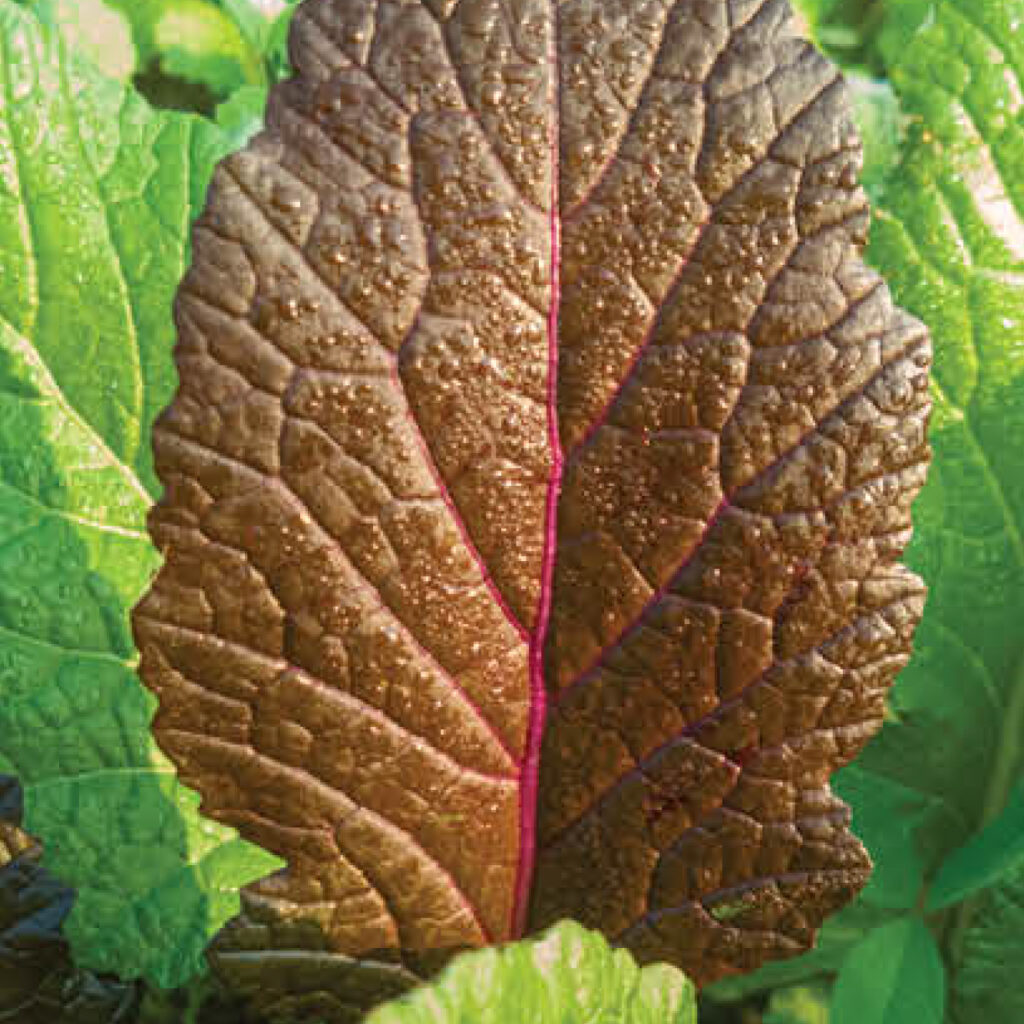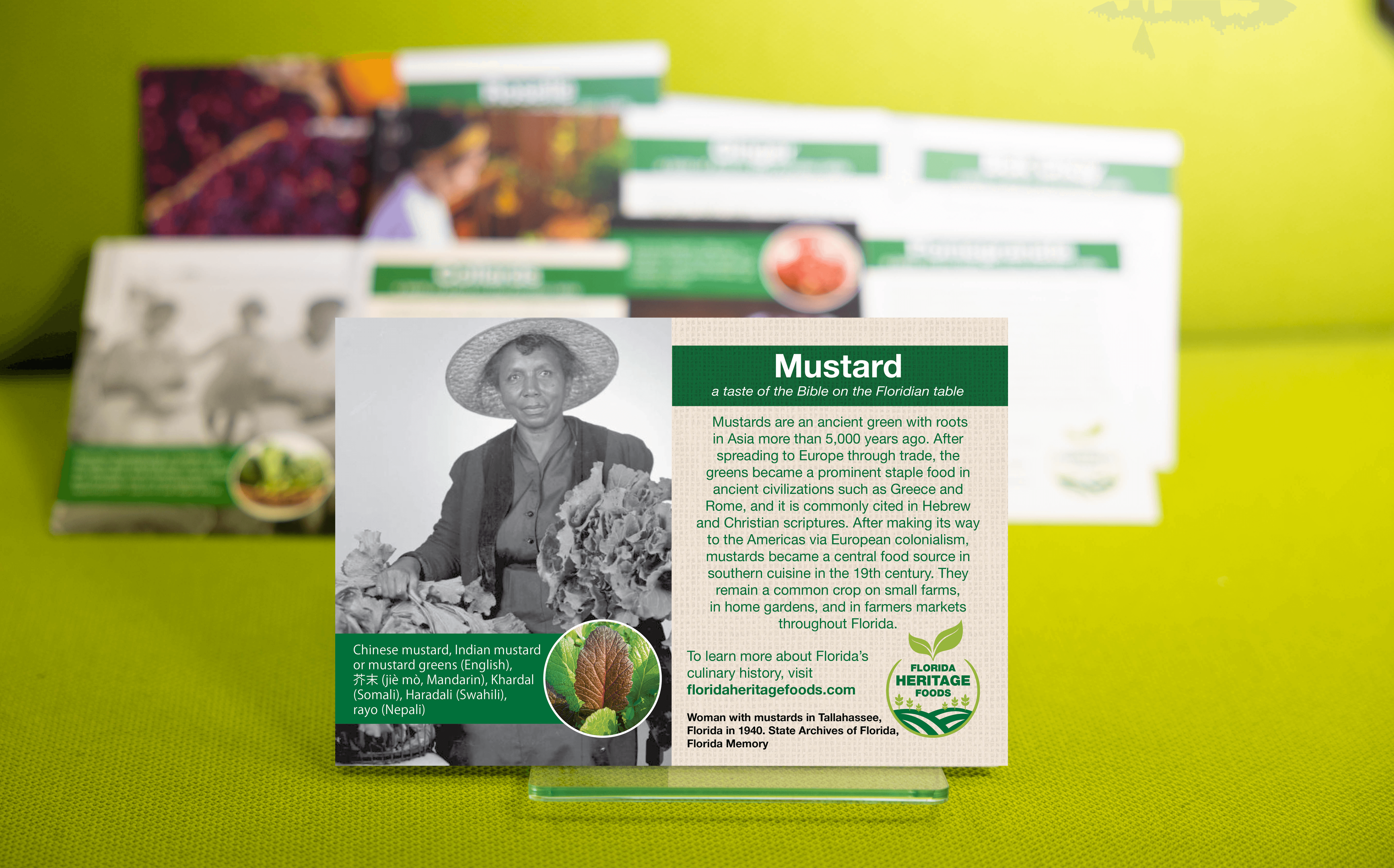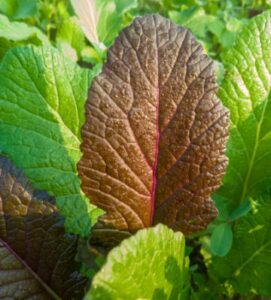Mustard
Brassica spp.

Chinese mustard, Indian mustard or mustard greens (English), 芥末 (jiè mò, Mandarin), khardal (Somali), haradali (Swahili), rayo (Nepali)
Mustards are an ancient green with roots in Asia more than 5,000 years ago. After spreading to Europe through trade, the greens became a prominent staple food in ancient civilizations such as Greece and Rome, and it is commonly cited in Hebrew and Christian scriptures. After making its way to the Americas via European colonialism, mustards became a central food source in southern cuisine in the 19th century. They remain a common crop on small farms, in home gardens, and in farmers markets throughout Florida.

Mustard greens can be traced to the Himalayan region of India where they were cultivated more than 5,000 years ago. Through trade they eventually spread to other parts of Asia and Europe and became a staple food in many civilizations such as ancient Greece, Rome and in Judaism and Christianity. During the Middle Ages, mustard greens became a popular vegetable in Europe, where they were grown in monastery gardens and used in both culinary and medicinal preparations. In the 16th century, mustard greens were brought to the Americas by European settlers, where they quickly became a staple food in many parts of the continent.
Mustard greens were introduced to Florida in the early 1800s by European settlers, yet it was not until the late 19th century that they became a popular crop in Florida. In the early 20th century, mustard greens became a key crop in the region’s agricultural economy, and many farmers grew the vegetable for both local consumption and export to other parts of the country. The popularity of mustard greens continued to grow throughout the mid-20th century, and by the 1960s, Florida was one of the leading producers of mustard greens in the United States. Today, mustard greens are still a popular crop in Florida, particularly in the northern part of the state, where they are grown on small farms and sold at local farmers’ markets and roadside stands. Mustard greens are also a popular ingredient in many traditional Southern dishes.
The ancient Greeks and Romans used mustard in a variety of dishes such as stews, salads and soups. Mustards were also used in ancient Israel as a condiment and seasoning. In Hebrew scriptures, the prophet Ezekiel describes a vision in which he is shown a new temple and a city, and he sees mustard growing in the city’s fields (Ezekiel 17:22-24). Mustard leaves were used in traditional Jewish cuisine and were often eaten as a bitter herb during the Passover Seder. Mustard is referenced several times in Christian texts in reference to faith, such as in Matthew 17:20 “…Truly I tell you, if you have faith as small as a mustard seed, you can say to this mountain, ‘Move from here to there,’ and it will move. Nothing will be impossible for you.” There is scholarly debate, however, if Jesus is referencing the plant or the tree that produces a condiment that shares the same name. Brassica nigra, or black mustard, is a type of mustard green that is cultivated for its dark-brown-to-black seeds, which are commonly used as a spice.
Mustard greens remain a common staple in many parts of the world today. In northern India, they are cooked and pureed into a dish called sarson ka saag. In China they are pickled, stir-fried, and chopped for serving in soup. In Florida and throughout many Southern states, mustard greens are a staple in Southern cuisine where they are prepared similarly to collard greens. Since they are easy to grow in the Florida garden, they are becoming increasingly popular in suburban gardens and container gardens throughout the state as well.

A highly nutritious vegetable, the mustard green offers a significant amount of vitamins A, C, and K; minerals such as calcium and potassium; and carotene


Plant in full sun by directly sowing seeds or with transplants September through March; harvest greens November through May. Varieties that do well in Florida include “Southern Giant Curled” and “Florida Broad Leaf”.
To plan a Florida heritage garden, download the ‘Planning a Florida Heritage Garden (PDF).’

Santa Fe College Partnered with Multiple Organizations in a Collaborative Effort to Bring Awareness of the Heritage Plants In Florida.
BY CULTURAL HISTORY
BY GROWING SEASON
DROUGHT TOLERANT PLANTS
Commitment to Equal Access and Equal Opportunity
Santa Fe College is committed to an environment that embraces diversity, respects the rights of all individuals, is open and accessible, and is free of harassment and discrimination. For more information, visit sfcollege.edu/eaeo or contact equity.officer@sfcollege.edu.
SACSCOC Accreditation Statement
Santa Fe College is accredited by the Southern Association of Colleges and Schools Commission on Colleges (SACSCOC). For more information, visit sfcollege.edu/sacscoc.
